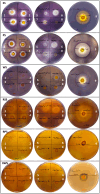Long-read, multi-amplicon sequencing to explore genetic diversity associated with starch degrading phenotypes in amylolytic Lactobacillaceae
- PMID: 40207158
- PMCID: PMC11980422
- DOI: 10.3389/fmicb.2025.1548052
Long-read, multi-amplicon sequencing to explore genetic diversity associated with starch degrading phenotypes in amylolytic Lactobacillaceae
Abstract
Characterizing starch-degrading Lactobacillaceae and associated enzymes remains relevant as various industries seek to harness their activity to produce valuable by-products, develop novel food applications, and to aid the sustainable bioconversion of starch-rich resources. To support this, we developed a targeted methodological and analysis framework utilizing complimentary phenomic and genomic assays informative of the starch degrading potential of Lactobacillaceae. Adapted starch agar plate assays incorporating diversified starch sources and states facilitated the rating of extracellular amylolytic activity by starch-processing-line isolates [Lactobacillus amylovorus (n = 3), Lactobacillus amylolyticus (n = 2), and Limosilactobacillus reuteri (n = 2)] as weak to moderate based on the complete or partial hydrolysis of retrograded soluble (SS), or potato and wheat (WS), starches, respectively, and the partial hydrolysis of raw SS. In contrast, the known raw starch degrader, L. amylovorus NRRL B4540, was rated as strong, with complete hydrolysis of all retrograded starch sources and raw WS. To explore genetic diversity and the putative enzymes associated with phenotypic diversity amongst L. amylovorus and L. amylolyticus, a multi-amplicon sequencing approach using MinION™ was used to simultaneously sequence starch-degradation-associated genes identified from them. Gene and deduced amino acid sequence analysis suggested raw starch hydrolysis by L. amylovorus NRRL B4540 was largely attributed to amyA encoding a rare α-amylase with unique starch binding domain (targeting α-1,4 linkages), but which was predicted to also require the starch debranching activity (targeting α-1,6 linkages) associated with (putative) pul-encoded pullulanase (Pul) for complete hydrolysis. Without amyA, Pul was hypothesized necessary for observed starch degradation by L. amylovorus and L. amylolyticus test isolates; as a previously undescribed amylopullulanase with dual activity, or as a pullulanase requiring complimentary α-1,4 activity from an additional enzyme, potentially Gly2 (a putative maltogenic α-amylase). Whilst further work is required to characterize these enzymes, including those encoded by gene variants, the experimental approach described here provided the necessary evidence to warrant this. Further, this framework is likely adaptable for the direct analysis of Lactobacillaceae-rich microbiomes for amylolytic potential and for the targeted screening of various other functions across different taxa.
Keywords: Lactobacillaceae; amplicon sequencing; amylolytic; gene assay; nanopore; phenotype; starch.
Copyright © 2025 Olivier, Bull, Bowman, Ross and Chapman.
Conflict of interest statement
SO, MB, and BC were employed by Quantal Bioscience Pty Ltd. The remaining authors declare that the research was conducted in the absence of any commercial or financial relationships that could be construed as a potential conflict of interest.
Figures


Similar articles
-
Development of an amylolytic Lactobacillus plantarum silage strain expressing the Lactobacillus amylovorus alpha-amylase gene.Appl Environ Microbiol. 1994 Oct;60(10):3529-35. doi: 10.1128/aem.60.10.3529-3535.1994. Appl Environ Microbiol. 1994. PMID: 7986030 Free PMC article.
-
Comparative characterization of complete and truncated forms of Lactobacillus amylovorus alpha-amylase and role of the C-terminal direct repeats in raw-starch binding.Appl Environ Microbiol. 2000 Aug;66(8):3350-6. doi: 10.1128/AEM.66.8.3350-3356.2000. Appl Environ Microbiol. 2000. PMID: 10919790 Free PMC article.
-
Starch-binding domain affects catalysis in two Lactobacillus alpha-amylases.Appl Environ Microbiol. 2005 Jan;71(1):297-302. doi: 10.1128/AEM.71.1.297-302.2005. Appl Environ Microbiol. 2005. PMID: 15640201 Free PMC article.
-
Engineering Saccharomyces cerevisiae for direct conversion of raw, uncooked or granular starch to ethanol.Crit Rev Biotechnol. 2015;35(3):369-91. doi: 10.3109/07388551.2014.888048. Crit Rev Biotechnol. 2015. PMID: 24666118 Review.
-
Engineering yeasts for raw starch conversion.Appl Microbiol Biotechnol. 2012 Sep;95(6):1377-88. doi: 10.1007/s00253-012-4248-0. Epub 2012 Jul 14. Appl Microbiol Biotechnol. 2012. PMID: 22797599 Review.
References
-
- Agati V., Guyot J. P., Morlon-Guyot J., Talamond P., Hounhouigan D. J. (1998). Isolation and characterization of new amylolytic strains of Lactobacillus fermentum from fermented maize doughs (mawè and ogi) from Benin. J. Appl. Microbiol. 85, 512–520. 10.1046/j.1365-2672.1998.853527.x - DOI
-
- American Society for Microbiology (2012). Starch Agar Protocol. Available online at: https://asm.org/ASM/media/Protocol-Images/Starch-Agar-Protocol.pdf (accessed July 25, 2024).
-
- Bart J. C. J., Gucciardi E., Cavallaro S. (2013). “Renewable feedstocks for lubricant production,” in Biolubricants, eds. J. C. J. Bart, E. Gucciardi, and S. Cavallaro (Woodhead Publishing), 121–248. 10.1533/9780857096326.121 - DOI
-
- Božić N., Lončar N., Slavić M. Š., Vujčić Z. (2017). Raw starch degrading α-amylases: an unsolved riddle. Amylase 1, 12–25. 10.1515/amylase-2017-0002 - DOI
-
- de Man J. C., Rogosa M., Sharpe M. E. (1960). A medium for the cultivation of lactobacilli. J. Appl. Bacteriol. 23, 130–135. 10.1111/j.1365-2672.1960.tb00188.x - DOI
LinkOut - more resources
Full Text Sources
Molecular Biology Databases

